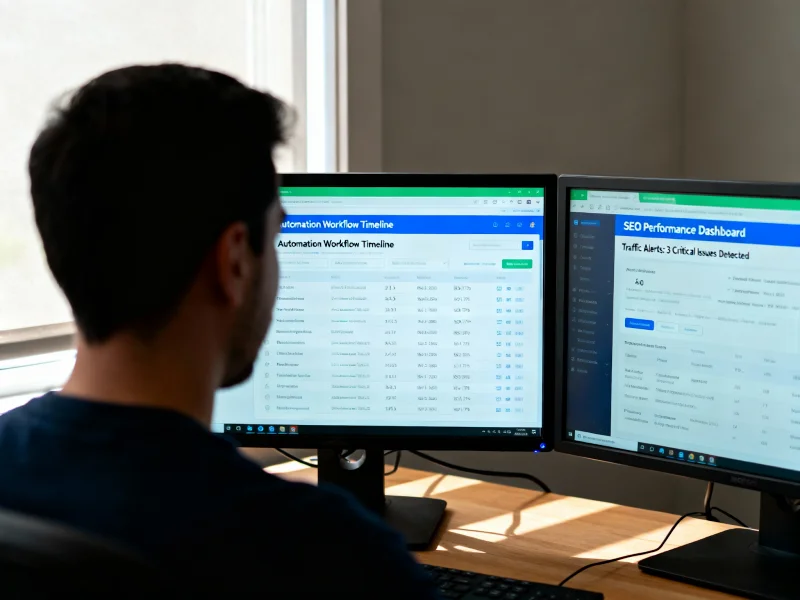How to Predict SEO Traffic?
Predicting SEO traffic growth requires a strategic approach grounded in data analysis. Businesses should leverage historical keyword performance and use traffic estimation models.
Understanding seasonal trends is crucial, along with conducting competitor analysis to identify new opportunities. It is also important to align content strategies with user intent.
As companies work to optimize their SEO efforts, a key question arises: how can they ensure sustained engagement and maximize their growth potential?
By focusing on creating valuable, user-centered content and regularly assessing performance metrics, organizations can better position themselves for long-term success in their SEO initiatives.
Key Takeaways
- Utilize historical keyword analytics to identify trends and forecast potential traffic increases based on past performance. This allows for informed decision-making that can enhance your SEO strategy.
- Apply traffic estimation formulas to predict growth by considering current traffic levels, anticipated rank improvements, and search volume. This analytical approach can guide your future content efforts.
- Analyze seasonal search patterns to adjust your content strategies. By optimizing for peak traffic periods, you can effectively capture audience interest and engagement.
- Take advantage of SEO tools like Moz Pro and ZISSOU to achieve accurate forecasting and strategic planning tailored to your specific business needs. These tools can provide valuable insights to enhance your SEO initiatives.
- Regularly refresh and optimize existing content to maintain visibility and engagement. This proactive approach helps ensure your content remains relevant and resonates with your audience throughout fluctuating traffic periods.
Understanding First-Party Data Collection
First-party data collection is essential for effective digital marketing strategies. This data is obtained directly from channels owned by the company, including websites, mobile apps, customer surveys, and transaction histories. It comes from user interactions such as website visits and social media engagement, as well as information gathered from customer relationship management (CRM) systems and customer service experiences.
There are various methods to collect this valuable data, including tracking user interactions through pixels, utilizing browser storage, and implementing event-based tracking. First-party data is recognized by 78% of businesses as a key resource for personalization. It offers insights into customer behavior, enabling targeted marketing strategies, enhancing customer experiences, and decreasing reliance on third-party cookies. This shift not only strengthens data security but also ensures compliance with privacy standards. Additionally, first-party data is crucial for predicting SEO performance and optimizing strategies for sustained growth.
Analyzing Keyword Performance and Trends
Analyzing keyword performance and trends requires a careful evaluation of historical keyword analytics to uncover patterns and fluctuations over time. Seasonal search trends can greatly influence traffic, highlighting opportunities for targeted content strategies. Understanding the relationship between click-through rates and traffic can inform optimizations that improve overall SEO effectiveness. By focusing on these insights, you can create content that is both relevant and engaging for your audience, ultimately enhancing their experience and driving better results. Additionally, identifying keyword gaps that competitors exploit can generate new content ideas and further bolster your traffic growth strategy.
Historical Keyword Analytics
While many marketers depend on current data for decision-making, gaining insights from historical keyword analytics is vital for anticipating future SEO traffic growth. By analyzing past performance, businesses can uncover valuable insights and trends that shape their strategies. Important aspects to consider include:
- Search Volume Analysis: Recognizing trends in the historical search volume of keywords.
- Keyword Ranking History: Monitoring changes in keyword rankings over time.
- Competitor Analysis: Gathering information on competitors' keyword strategies to identify opportunities.
- Conversion Potential: Assessing historical conversion rates to forecast future performance. Additionally, leveraging historical data helps avoid misinterpretation of short-term ranking fluctuations and provides insights into long-term performance against competitors.
Utilizing tools like Google Analytics and Semrush allows marketers to analyze these components effectively, setting the stage for informed decisions and optimized content strategies that drive growth. This approach not only enhances understanding but also supports the development of targeted strategies that align with user needs.
Seasonal Search Patterns
Understanding seasonal search patterns is essential for marketers looking to optimize their SEO strategies effectively. Utilizing tools like Google Trends and Ahrefs' Keyword Explorer allows marketers to analyze fluctuations in search interest and pinpoint peak seasons for specific keywords. By comparing multiple keywords, marketers can assess their seasonal relevance, while monitoring competitors provides valuable insights into market trends.
Implementing time-based strategies, such as focusing on major holidays or events, enables targeted content optimization. Weather-related strategies can also help adjust keyword usage in response to seasonal changes. Refreshing existing content and leveraging historical data can enhance visibility during high-traffic periods, leading to improved engagement and conversions. Recognizing these patterns is crucial for effective SEO planning, as seasonal trends can significantly impact consumer behavior and search interest.
CTR and Traffic Correlation
Understanding seasonal search patterns is essential for assessing Click-Through Rate (CTR) and its relationship with organic traffic growth. A higher CTR can improve organic rankings, as Google views CTR as an important ranking factor. Analyzing keyword performance provides valuable insights:
- Enhanced CTR is linked to notable improvements in rankings.
- Consistent low CTR can lead to declining rankings.
- It's important to optimize meta descriptions and titles if CTR is low.
- Utilizing tools like Google Search Console and Ahrefs can effectively measure and analyze CTR.
Utilizing Formulas for Accurate Forecasting
Accurate forecasting of SEO traffic growth involves applying specific formulas that help quantify potential outcomes based on various factors. One important formula estimates traffic based on ranking improvements. This is calculated by taking the Current Traffic and multiplying it by the Expected Rank Increase, then dividing it by the Current Rank Position. Another effective method is CTR-based traffic estimation, where Estimated Traffic is determined by multiplying Search Volume by Expected CTR.
To calculate average traffic increments, you can sum the percentage changes in traffic over a period of months and then divide that total by the number of months. For new keywords, estimating monthly traffic can be done by using the total keyword search volume along with the average CTR. These formulas offer a structured approach to predicting traffic, enabling marketers to plan strategically for future growth.
Leveraging SEO Forecasting Tools
In the field of SEO traffic prediction, utilizing forecasting tools can significantly improve both accuracy and effectiveness. Each tool presents unique features, making it important to choose one that fits your specific goals and requirements. By understanding the essential functionalities of both free and paid options, you can make a well-informed decision that aligns with your needs.
Key Features Overview
Navigating the intricacies of SEO can be challenging, but businesses can gain a significant advantage by utilizing SEO forecasting tools. These tools are equipped with essential features designed to improve traffic predictions and support informed decision-making. Key features include:
- Data Collection and Analysis: These tools gather metrics from multiple sources to evaluate traffic potential comprehensively.
- Predictive Modeling and Forecasting: Utilizing AI and statistical models, these tools deliver precise traffic predictions to guide strategic planning.
- Customization and Scenario Planning: Users can adjust models according to their unique business objectives, ensuring relevance and effectiveness.
- Visualization and Real-Time Monitoring: Complex data is transformed into clear, actionable insights, allowing businesses to monitor performance effectively.
Choosing the Right Tool
Selecting the right SEO forecasting tool is essential for businesses that want to improve their online visibility and increase traffic. Different tools serve varied purposes; for example, Ahrefs is known for its strengths in link building and keyword analysis, while SEMrush offers a comprehensive suite that suits larger organizations. Moz Pro strikes a balance between forecasting and general SEO tools, making it a good choice for those just starting out. ZISSOU distinguishes itself with free, AI-driven forecasting capabilities that cater to businesses of all sizes.
Effective tools should integrate data from Google Search Console and Analytics, as well as third-party sources for enhanced accuracy. Customization and ease of use are also key factors; ZISSOU allows users to adjust parameters, whereas Moz Pro offers educational resources to guide users. In the end, the right tool can improve forecasting accuracy and support strategic planning in a dynamic online landscape.
Planning Effective Content and Link Building Strategies
Effective planning of content and link building strategies is vital for achieving sustainable SEO traffic growth. A well-organized approach can significantly boost visibility and user engagement. The following key aspects should be prioritized:
- Content Strategy Planning
- Clearly define your niche or industry.
- Conduct in-depth market and audience research.
- Perform thorough topic and keyword research.
- Generate specific content ideas that resonate with your audience.
- Content Creation and Optimization
- Produce high-quality, original content.
- Optimize content to align with user search intent.
- Utilize a logical structure for headings.
- Incorporate elements that encourage user engagement.
- Link Building Strategies
- Commit to a consistent link building practice.
- Seek links from relevant and authoritative websites.
- Use relevant keywords in anchor text for better context.
- Create content that is worthy of sharing and promotes engagement.
- Monitoring and Adjustment
- Regularly track the performance of your links.
- Analyze user engagement metrics to understand audience behavior.
- Make adjustments based on performance insights to enhance effectiveness.
Refining and Tracking Your SEO Forecasts
Planning content and link-building strategies are essential for achieving success in SEO, but the ability to refine and track forecasts ensures ongoing growth and adaptability. To improve accuracy, businesses should gather historical organic traffic data from Google Analytics and Search Console, focusing on monthly variations over a period of 12 to 24 months.
By analyzing seasonal trends, you can adjust projections based on expected fluctuations. It is also important to consider external factors, such as algorithm changes and market trends. Employing statistical models like linear regression can help in making future traffic predictions while estimating keyword-based traffic connects search volume with potential organic traffic.
Utilizing SEO tools for automation can streamline the forecasting process, ensuring that your strategies remain aligned with the ever-evolving online landscape.
Evaluating ROI and Resource Allocation for SEO Efforts
Many businesses invest in SEO with the aim of boosting visibility and increasing revenue. However, evaluating return on investment (ROI) and allocating resources effectively are essential steps to maximize the impact of these initiatives. To assess SEO ROI effectively, consider the following steps:
- Calculate ROI: Utilize the formula (Value of Conversions – Investment) / Investment to determine your returns.
- Track Conversions: Use tools such as Google Analytics 4 to monitor the revenue generated from your SEO efforts.
- Measure Over Time: Allow a period of at least six months following implementation to accurately evaluate ROI.
- Budget Allocation: Allocate resources in a flexible manner, focusing on content, off-page, and technical SEO in accordance with your business priorities.
Drive Results with Off Page SEO Services
If you’re determined to see measurable improvements in your digital presence, investing in off page SEO services can be a game changer. You have the power to tap into strategies that focus on generating quality backlinks, improving citation profiles, and building a robust online reputation. This methodical approach ensures that every link and endorsement contributes to your site’s overall authority and trustworthiness.
By adopting these techniques, you’re setting a clear path toward enhanced visibility and increased organic traffic. For further expertise and proven methodologies, explore the comprehensive solutions offered by a leading top digital marketing agency that’s well-versed in the latest digital trends and best practices.
Conclusion
To predict SEO traffic growth, you need to analyze historical data from your website traffic, including keyword rankings, search volume, click-through rates (CTR), and competitor analysis, using tools like Google Analytics and dedicated SEO platforms to identify trends and project future traffic based on planned SEO strategies and anticipated ranking changes; key factors to consider include keyword research, content quality, technical optimization, seasonal fluctuations, and potential algorithm updates from search engines like Google.
Plan your future success with a discovery session from Authority Solutions® that uncovers actionable insights for forecasting SEO traffic. Let our experts help you build a resilient digital strategy that stands the test of time.
FAQs
How can I use methods of SEO forecasting to predict future website traffic?
You can predict SEO traffic by using forecasting methods that analyze historical search trends, SEO metrics, and keyword data to estimate future organic performance. These techniques help generate a traffic projection that reflects your website’s SEO potential. By understanding past traffic patterns and aligning them with ongoing SEO efforts, you can set realistic goals and refine your strategy. This approach not only helps forecast future traffic but also supports long-term growth through targeted optimization.
What are some effective strategies to forecast SEO growth and organic traffic based on historical data?
To forecast SEO growth effectively, you should use statistical forecasting methods that analyze historical data and SEO metrics. These methods of SEO forecasting help you predict the future organic traffic and identify potential increases in search traffic. By conducting a thorough traffic forecast, you can understand website performance and set realistic goals. This approach allows you to estimate future growth, track monthly organic traffic trends, and optimize your SEO strategies using third-party SEO tools and free SEO reports.
Why is SEO forecasting important for predicting the future impact of your search engine traffic?
SEO forecasting is important because it uses historical data to predict the future impact of your search traffic, helping you set realistic SEO goals. When you forecast SEO traffic, you’re able to see estimated organic traffic increases and adjust your strategies accordingly. This process of predicting website traffic ensures that you’re prepared for fluctuations in search engine performance and can implement SEO services to boost organic growth over time.
How do SEO metrics and click-through rate data help forecast organic traffic and SEO progress?
SEO metrics, including click-through rate data and keyword performance, provide valuable insights for forecasting organic traffic. By analyzing these metrics, you can predict the future SEO traffic and understand how users interact with your content. Using this information in your traffic forecast enables you to adjust your on-page optimization and content strategies to improve organic search traffic. This detailed analysis helps predict future website traffic and supports effective SEO forecasting that drives SEO success.
What role does a traffic forecast play in estimating future organic traffic for a new website?
A traffic forecast is crucial for a new website because it uses historical data and current SEO metrics to predict future organic traffic. By employing SEO forecasting techniques, you can estimate how much traffic your website might receive based on search traffic trends and keyword performance. This process of predicting website traffic allows you to set realistic expectations and plan effective SEO strategies that optimize your site's SEO potential and drive organic growth over time.
How can free SEO tools aid in forecasting organic traffic and predicting SEO potential?
Free SEO tools can be highly beneficial in providing a traffic forecast by analyzing current SEO metrics and historical data. These tools help you predict future organic search traffic and give insight into your SEO potential through comprehensive SEO forecasting reports. By using free SEO platforms, you can monitor key indicators like click-through rate and monthly organic traffic, allowing you to make informed decisions that lead to better SEO success and overall website performance.
How does forecasting organic search traffic help improve your website ranks on search engines like Google?
Forecasting organic search traffic helps you predict future website performance by analyzing past SEO metrics and traffic patterns. This approach enables you to identify potential increases in search engine traffic, forecast SEO growth, and optimize your on-page content accordingly. With an accurate traffic forecast, you can implement targeted SEO services and use this information to predict the future impact on your website ranks, ultimately boosting organic traffic and improving overall SEO success.
What are some key SEO forecasting techniques to predict future traffic growth effectively?
Key SEO forecasting techniques involve using statistical models, keyword forecasting methods, and analyzing historical data to predict future website traffic. These methods allow you to generate a detailed traffic forecast, estimate organic search traffic, and set realistic SEO goals. By employing these forecasting techniques, you can assess SEO potential, track SEO metrics over time, and plan strategic adjustments to increase organic traffic based on current SEO trends and performance data.
How can you forecast website traffic growth using SEO forecasting models and traffic patterns?
Forecasting website traffic growth requires analyzing SEO metrics and traffic patterns based on historical data. SEO forecasting models help you predict future organic traffic by estimating website performance and setting realistic goals. By using these models, you can forecast SEO traffic growth, measure monthly organic traffic, and adjust your SEO strategies accordingly. This process of predicting future traffic ensures that you can optimize your content and improve your website’s overall SEO performance, leading to increased organic search traffic.
How do SEO forecasting techniques assist in setting realistic SEO goals and tracking SEO progress?
SEO forecasting techniques involve analyzing past performance, search traffic, and organic search metrics to predict future website traffic. By using these methods, you can develop a reliable traffic forecast that helps you set realistic SEO goals and monitor progress over time. Accurate SEO forecasting is important because it not only predicts future organic traffic but also identifies areas where SEO services can improve website performance. This ongoing process ensures that you’re always prepared to adjust your strategies and maintain effective SEO progress.









